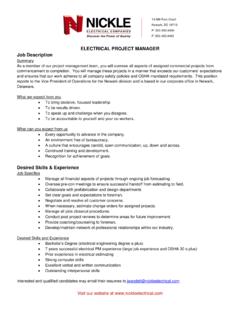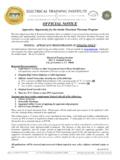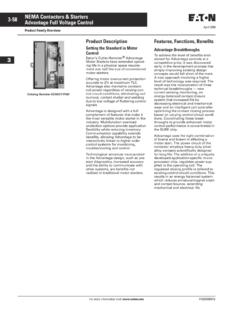Transcription of A SHORT DESCRIPTION OF THE ELECTRICAL …
1 A SHORT DESCRIPTION OF THEELECTRICAL principles ANDTONAL COMBINATIONS OF ANEW MUSICAL INSTRUMENTWORLD PATENTEDINDEX TO CONTENTSC horus GeneratorDiapason Tone QualityElectrical PrincipleFlute Tone ControllerHarmonic Controller, PedalOrganHarmonic Controls, Black andWhiteHarmonic Controls, BrownHarmonic s SeventhPipe Organ MixturesPipe Organ StopsPreset KeysPreset Pistons (Model E)Reed Tone QualityString Tone QualitySuper and Sub-Octave Coupler ,1618,198,16187101415141315579,16,178,16 14 Swell PedalsToe Pistons (Model E)Tone ColoursTone Colour CombinationsTone FamiliesTone WheelTremulantILLUSTRATIONSAND DIAGRAMSThe Hammond OrganPlan of ConsoleHarmonic ControllerPre-set Pistons (Model E)Graphs and Wave PatternsSynchronous Motor and Gen-erator , 171718114666918 OUTSTANDING FEATURES It has the full range of organ tone colours. Its range of expression is many times greater than that of other organs. It occupies only a few square feet of floor space.
2 It is ready to play wherever there is an electric outlet. It cannot get out of tune, having no reeds nor pipes. It is not affected by atmospheric or temperature conditions. Its maintenance is negligible. The standard installation uses about as much current as four ordinary light bulbs. Its response and repetition are instantaneous- no lag. It is a beautiful piece of furniture. It is easily moved, It is fully guaranteed. It is made by a well-established organization with a world-wide reputation for precision in manufacturing. Its price is but a fraction of that which any instrument at all comparable would cost. But, after all, there is no comparable instru- organ that is without pipes or wind may wellindeed be called a new Hammond Organ, here pictured and described,is not merely new; it represents in itself a revolutionso far-reaching as to be quite incalculable.
3 New chaptersin our social history were opened when, two or threegenerations ago, the telephone and the typewriterarrived on the scene There can be no doubt whateverthat the advent of this new instrument must have anequally startling significance in the world of musicScience and the laws of dynamics have been so harnessedto the inventor's will that he has created an instrumenteminently suitable for the drawing room yet, whenoccasion demands, powerful enough to fill a Cathedralwith a tone of great nobility and sweetness It isremarkably adoptable for installation purposes The minimum floor space which it needs never exceeds fouror five feet squareThe actual "Furniture" of the instrument consists ofbut two pieces the console and the power cabinet, whichis connected to the console by a cable and can be placedin any convenient part of a room or building.
4 Thenumber of cabinets may be multiplied forlarge buildings, as ThreeCHAPTER IT H E T O N A L C O N T R O L S O FTHETHE HAMMOND ORGAN HAMMOND ORGANXCEPT where otherwise mentioned, the following descriptions apply equally to every model of the Hammond of the three models, A, B and E, is ideally suitable for its particularpurpose. Models A and B will give every satisfaction in the small churchor auditorium or in the home. There is hardly a limit to the scope ofmusic which can be played on either of these two E console represents the ultimate in organ design and can betermed a professional organist's instrument. Whilst being perfectlysuitable for use in the home or in the smallest or largest building, it is soequipped that every DESCRIPTION of organ literature may be played with awealth of dynamic interpretation hitherto unthought is designed on more ecclesiastical lines than the others, so as to betterharmonise with church appointments.
5 Massive in appearance, it is nearlyas portable as Model 1 shows the various controls marked. The pre-set keys are atthe left-hand end of each manual. The tremulant control is located justabove the pre-set keys. Immediately over the upper manual are fivegroups of are two groups of harmonic controls of nine draw-bars each, onthe left-hand side; these operate on the upper manual. The two groupsof nine harmonic controls on the right operate on the lower these groups are two other harmonic controls; these operateon the PRE-SET KEYS, Models A and B Consoles (Figure 1).At the left end of each manual is an additional octave of reverse colourkeys-that is, the naturals are black and the sharps white. Theseare the pre-set keys. Those to the left of the lower manual are associatedwith that manual, those above with the upper a pre-set key is depressed it stays down.
6 When a second key onthe same manual is depressed the first key springs up and the second remainsdown. Up, the pre-set key is "off"--not functioning. Depressed,it is on. Only one pre-set key should be depressed on the same manualat one key at the extreme left, C, is the cancel key, used only to clear thepre-set keys when two have been depressed by FiveFIGURE 1. PLAN OF CONSOLE (Model A)FIGURE E Console. Manual Pre-set Piston Indicators. Tremulant LeversFIGURE Pedal Indicators. ChorusControl. Starting and Running 2. A HARMONIC CONTROLLERPage SixThe two pre-set keys at the extreme right, A# and B, are really switchkeys. when A# is depressed the organ speaks with whatever tone Colouris set up on the left one of the two harmonic controllers for that B is depressed the organ speaks according to the right hand con-troller for that intervening pre-set keys, C# to A inclusive, are each associated witha different ready-mixed tone quality set up before the organ is keys correspond to the pistons on a pipe organ.
7 They are generallyuseful tone qualities. The artist may, however, substitute any otherpre-set quality he prefers for any or all of them by a simple method fullyexplained in the operating tone of the organ is changed from one quality to another while playing,merely by depressing another pre-set two manuals are really duplicates of each other, each having its ownpre-set keys and two harmonic should be clear from the above that, before playing, the organist mustfirst depress one of the pre-set keys associated with the manual on whichhe is about to PRE-SET PISTONS, Model E Console (Figure la)On the Model E Console, small pistons (numbered 0 to 11) are employed,instead of the reverse colour keys. A label against each piston indicatesthe tone quality associated with it. The piston marked "0" is the cancelkey and Nos. 10 and 11 are available for any tone qualities that mayappeal to the organist by manipulation of the drawbars as HARMONIC CONTROLLER (Figure 2).
8 The Harmonic Controller is the device by which the artist is enabled tomix the fundamental and any or all of 8 different harmonics in variousproportions. It consists of 9 drawbars. The third drawbar from theleft controls the fundamental. Each of the other drawbars controls aseparate harmonic as shown on the diagram. Each drawbar may be setat any one of 9 different positions. If pushed all the way in, againstthe console, the element it represents is not present in the mixture. Itmay be drawn out to 8 different positions. These are marked on thedrawbar and may be read by the artist. Each position represents a differentdegree of intensity of the element it controls. When drawn out to position1, the element it represents will be present in the mixture with minimumintensity, when drawn out to position 2, with greater intensity, and so on,up to position tone colour is logged by noting the numerical position of the variousdrawbars.
9 For instance, the tone set up in the diagram (Figure 2) is knownas tone 23,6444,222. After a tone is so logged it may be made availableagain by setting up the harmonic controller to that order to make full use of the Hammond method of tone composition,the artist should understand the general characteristics of the varioustone four principal families of organ tones are Flute, Diapason, Stringand SevenFLUTE TONE flute tone is a comparatively simple tone. Its harmonic developmentis concentrated chiefly on the fundamental and second harmonic overtone,with occasionally the addition of one or two other harmonics. Therelative proportion of these components varies for the different kinds 00,3500,000 is a quality like that of the pipe organ stop Flute d amour." combination 00,5200,000 is a dopple flute 00,5310,000 is a melodia quality 00,5000,000 is, of course, also very flute-like in its is a pure fundamental tone, however, without harmonic developmentand the musician is cautioned against employing it or any other singlefundamental.
10 Its total lack of harmonic development is both unnaturaland unmusical. For a tone to possess character, it must have some har-monic development, and the player should employ only tone colours con-taining some such will be apparent that even in this family, the simplest of the tone families,there is a large number of variations available to the artist from which hemay choose that particular quality which pleases him TONE diapason quality is a foundational tone of the pipe organ. Thereare various kinds of diapason qualities. All diapasons have both a strongfundamental and second harmonic with relatively weak upper harmonicdevelopment. The diapason qualities differ from each other principallyin the number and strength of the upper harmonic 00,5521,000 is an example of phonon diapason 00,5442,420 is an example of violin diapason pipe organs, the diapason stops are usually strengthened harmonicallyby the addition of mixtures or harmonic corroborating tones.






